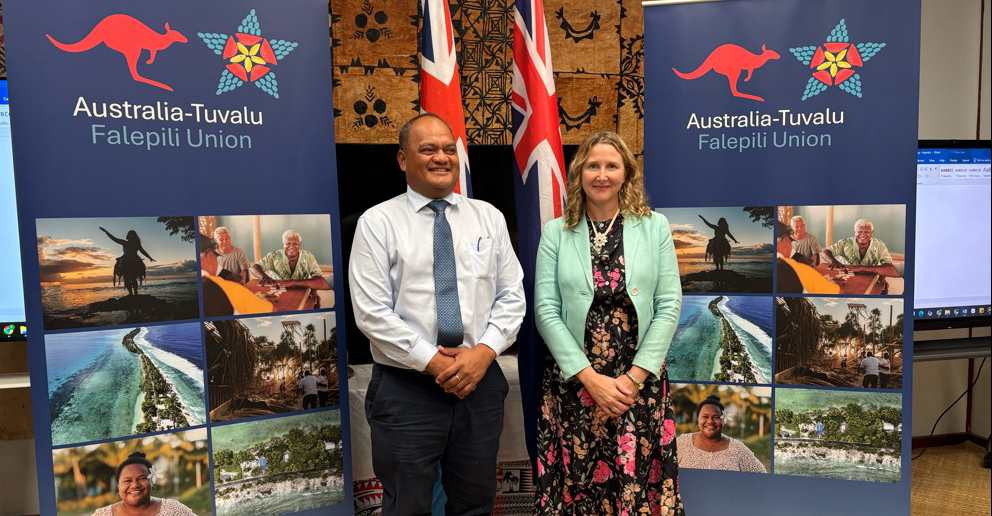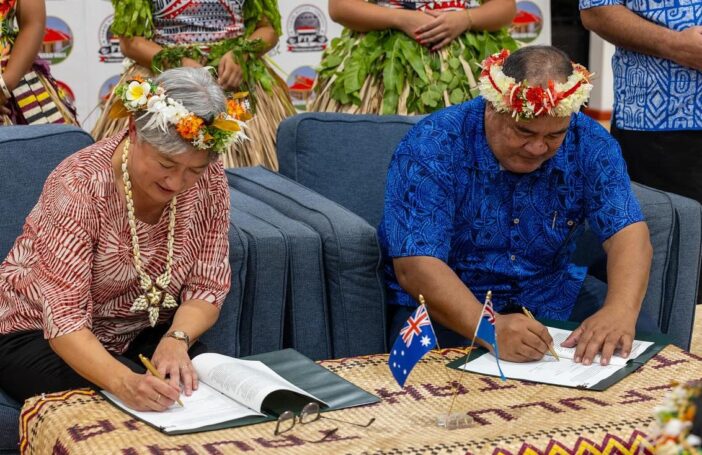The Falepili Union treaty stream visa ballot for Tuvalu citizens opened on 16 June 2025 and closed on 18 July. Registration cost A$25 (Tuvalu uses the Australian dollar) and 3,125 people applied in the first four days. In total, 8,750 or more than half of Tuvalu’s citizens applied by the close of the ballot — leading to some obvious questions. Is everyone going to leave? Is this the brain drain we keep hearing about?
The Falepili Union is a migration-security deal. Security is broadly defined, per the Boe Declaration, but the crux of the deal is simple: “any partnership, arrangement or engagement with any other state or entity on security and defence-related matters” needs to be agreed with Australia (3.4) in return for Australia’s providing Tuvalu with a special migration pathway (3.1). Either party can walk away at any time (although there is a 12-month period until effect). This is the closest thing we have to a compact. Its climate angle is especially important to note, as Tuvalu is one of only a few Pacific island states at such extreme risk of total population displacement due to climate change (and therefore also presents low foreign geographic expansion risk vis-a-vis other states).
Each year from 2025, 280 places are to be allocated by random ballot under the treaty stream. As with the Pacific Engagement Visa (PEV), there is no minimum residency requirement for benefits and services (full comparison matrix here). However, Falepili visas differ from PEV visas (Tuvalu was part of the PEV ballot in 2024 but will not be in 2025) in three important respects. First, there are no maximum age or disability requirements. Second, ballot winners do not need to secure a job offer before a visa is granted. Third, it is not a “use it or lose it” (usually within five years) visa.
PEV and Falepili visas differ significantly from New Zealand’s equivalent, the Pacific Access Category (PAC), in at least one important additional dimension: cost. PAC visas cost at least (depending on applicant circumstances) NZ$1,389. For a first-time registration for a Tuvaluan (in Tuvalu), ballot entry (stage one) costs NZ$86. For ballot winners, the resident visa application (stage two) then costs NZ$1,280. By contrast, in Australia, stage-one ballot registrations cost A$25 and stage-two visa applications cost A$200 for Falepili and start at A$335 for the PEV (additional adults and children cost extra), which is equivalent to more than four weeks’ consumption back home for the median Tuvalu citizen. All these costs are significant — and sit on top of airfares and other relocation costs — but the associated New Zealand costs are more likely to constrain participation and getting started abroad.
The implications of this new Tuvalu visa stream for Australia, at least in terms of the usual migration discourse around housing, jobs and infrastructure, are trivial. 280 visas per year is a small fraction of a single percentage point of Australia’s annual permanent migration intake. The Falepili visa is also incredibly popular in Australia: only about 15% of people in Australia don’t want it expanded to more countries, or want it cut.
The potential implications for Tuvalu are, however, more important.
Tuvalu is a small island nation with a resident population of 10,643 at the last census in 2022. 280 citizens represent about 2.8% of the current resident population, less if eligible Tuvaluans abroad are included (over 3,000 in 2019, according to UNDESA’s International Migrant Stock database, excluding the 211 citizens reported to be in Australia). Concerns around a so-called brain drain, which I’ve written about before, don’t ever seem to go away, regardless of context. Since everyone seems to know about the Falepili visa, an enormous share of those who know applied, and given those selected in the ballot do not need job offers to apply for their visas, there should be little or no bias in favour of skilled workers.
Thus, the main concern is population decline, not losing skilled workers per se. If all residents wanted to leave, others estimate it would take between 30 years and 40 years for the total population to leave at a rate of 280 per year. This concern has generally not been realised for other countries with open labour market agreements, of which there are many, and there is high-quality research explaining why not everyone moves and why people return.
Tuvalu has a labour force participation rate of just under 25%. The remaining three quarters of the working age population are not working and not looking for paid work. A further 8% of the 25% participating are unemployed (seeking work) and more than 25% are informally employed — about the same as two decades ago. Tuvalu has a young population and almost one in five economically active young people (that is, people aged 15-24 participating in the labour force) are unemployed — almost triple the unemployment rate of the labour force as a whole. Good, well-paying jobs are not in high supply and are usually provided by the government (Tuvalu is an archetypical “MIRAB” economy, heavily reliant on external sources of income; for example, net foreign income is as high as GDP). Job scarcity and economic opportunities are the first-order issues. The fact that people can freely bring their families could be transformational for these young people.
How about current levels of well-being and the potential benefits for those who move? Median consumption in Tuvalu was A$3,887 per year in 2022, and the country’s basic-needs poverty line is A$2,688 per year. This is equivalent to about seven dollars a day. 21.5% of the population lives below this poverty line. Australia’s minimum wage (A$24.95 from 1 July this year) is more than three times this in a single hour (pre-tax and transfers) so we should expect large income gains for movers even at the lowest possible baseline. More than 60% of Pacific migrants in Australia, for whom migration through New Zealand has been the dominant pathway, do however settle in areas in the bottom two quintiles of relative socioeconomic disadvantage. As Stephen Howes noted in a recent submission, Tuvaluan PAC visa holders typically have weaker labour market outcomes in NZ, and it will be important to monitor the settlement outcomes of this new cohort in Australia carefully.
Will more Pacific countries seek to move beyond the PEV and secure the advantages of the Falepili visa and an increased quota? Time will tell.





Thank you so much, Niuone! These two important points, which I agree with and have tried to factor in above as best as the current pubic information lets us. My sincere apologies if that did not come through clearly enough.
I was not game to do my own estimates (on that part nor projections) and relied on others reportedly official stats. Home Affairs should be able to say how many unique applicants there are, and how many appear twice, but I suspect the official number reported is simpler (e.g. applicant + dependents summed across every application, even if duplicates).
Your New Zealand clarification is also helpful. The figure I used to revised the public 2/3 down to about half and include those abroad further down is UN DESA data from 2009, which had 1,515 Tuvalu born “migrant stock” in NZ in 2019, but the 2018 census had 1,855 and 2023 census 2,244, and I’ve seen reports of around 6,500 resident Tuvaluans in NZ as you say too, but am not sure of the breakdown or source. Either way, it makes the share of current resident applicants lower as you say. By how much, we’d need to see how much info is collected from Home Affairs on applicants.
Thanks again for the clarification and bringing these points up,
Ryan
This is a great blog, Ryan. However, there are a few important aspects missing and particularly regarding the number of applications. Many families submit multiple entries to increase their chances of success. For example, both the husband and wife may apply separately, while still including the same dependents. As a result, although the overall number of applications appears high, a large portion of it is made up of these duplicate submissions.
Additionally, there is significant interest prior to the opening of the scheme from the Tuvaluan diaspora in New Zealand and even in Australia. And I know some of whom already hold New Zealand residency or permanent residency applied. With an estimated 6,000–7,000 Tuvaluans living in New Zealand, I think the actual number of applications coming directly from Tuvalu itself may be smaller than the reported 8,750.